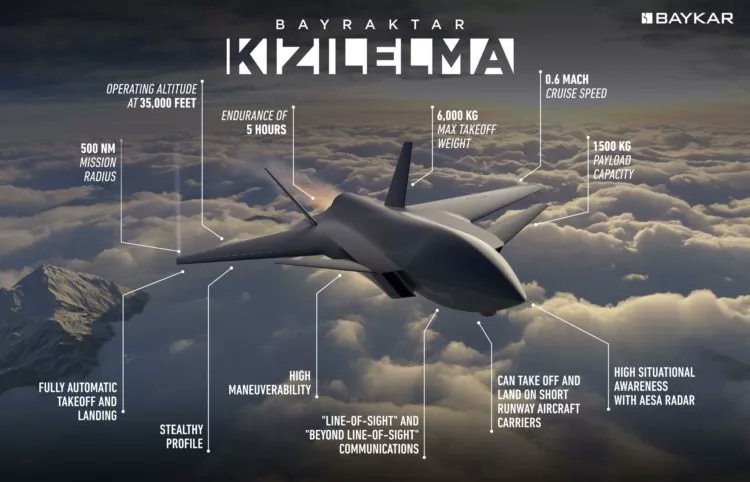Turkey continues to develop its drones, with the first flight of a jet-powered fighter aircraft expected to partially offset the country's ban on F-35 purchases.
First flight for Turkey's upcoming combat drone
Turkish company Baykar announced on Dec. 14 that its new combat drone, the Kizilelma, had completed its first flight. The president of the company, Selçuk Bayraktar, published on his Twitter account videos on which one can see the device taking off and landing. According to him this drone represents " the will of Turkey to be free and independent in its sky ". Its name, Kizilelma, means both " Great Ideal " and " red apple " and refers to a myth, which highlights the Turkish identity and an ideal to achieve. Through this project (called MIUS), Turkey seeks to compensate for the inexorable aging of its fleet of fighter aircraft while the U.S. has prohibited the country to modernize its F-16 or acquire the F-35 fighter, retaliation to the Turkish attitude in Libya, the Aegean Sea or around Cyprus, but also the purchase of S-400 air defense systems. The objective is also to produce a drone relying less on imported equipment, the vast majority of systems making up the famous TB2 coming from abroad.
Ambitious goals and innovations
The aircraft, according to Baykar, would have a maximum takeoff weight of 6 tons for a payload of one and a half tons, a " combat radius " of 926 kilometers for an endurance of 5 hours and a cruise speed of Mach 0.6. It is described as very maneuverable, stealthy and able to communicate "beyond the line of sight". Its Ukrainian-origin turbojet engine (AI-322F Turbofan from Ivchenko Progress) would allow it to accelerate to Mach 1.
As a comparison, an MQ-9 Reaper has a payload capacity of 1,700 kg and can fly for 14 hours up to 1,900km at full load. However, the latter only has a synthetic aperture radar while the MIUS will have an AESA radar.
The Kizilelma would cost "only" 30 million euros, which is again similar to the MQ-9 Reaper posted at $32M. The drone will be capable of air-to-ground combat missions, but would also have air-to-air capability and will be equipped with artificial intelligence that will allow it to perform part of its mission autonomously.


The concept of the drone carrier
Turkey launched the construction of the TCG Anadolu in 2016, it will be its first projection ship and it is planned to become the flagship of the country's fleet. Currently in the testing phase, this ship could become the world's first drone carrier due to the lack of suitable aircraft to acquire. The Turkish Navy wants to operate the Bayraktar TB3 (a navalized and improved model of the TB2) and the Bayraktar Kizilelma from the deck of this ship initially planned to accommodate the B version of the F35 Ligntning II.
Today, only the US Navy has officially succeeded in operating a drone of significant size from a ship (see our article about the MQ-25 to be fitted to US aircraft carriers). The US, which has been working for several decades on the development of large aircraft capable of taking off and landing from its aircraft carriers.
If Turkey also succeeds in developing this capability, it will once again demonstrate that it is a major international player in the field of unmanned aircraft. If Ankara manages to give its Kizilelma all the expected specifications, the country would enter the big league in the field of UAVs, matching or even surpassing the performance of some UAVs offered by the United States.


Découvrez cet article sur Air&Cosmos

